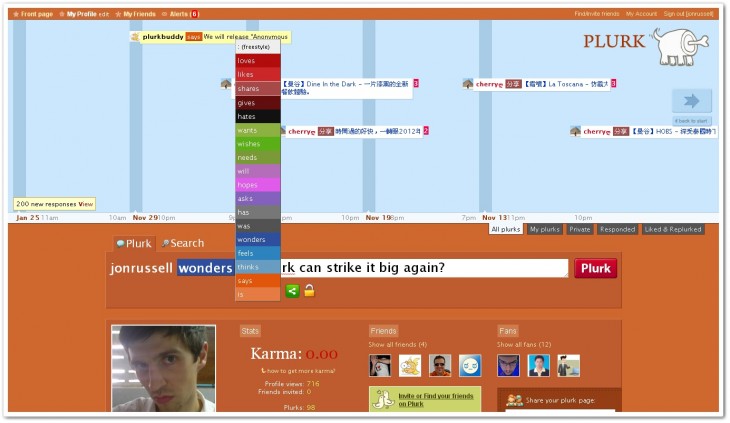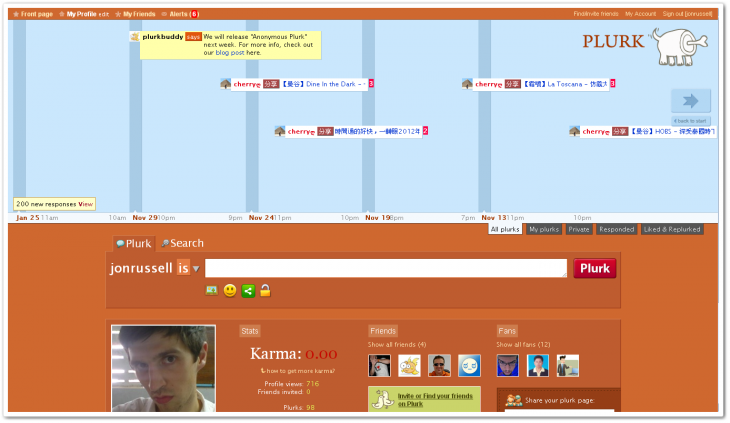
If you’re an early user of Twitter, or someone who enjoyed social networking when it began to go mainstream around 2008, then the chances are that you may remember Plurk. The Canadian startup offered a more visual take on Twitter and FriendFeed (another once popular service), and today’s its being reborn with a funding round and after it relocated to Asia.
Seeing the majority of its traffic from Asia, the company has been “restructured” and is now headquartered in Taipei, Taiwan, while it has landed undisclosed amount of funding — which is “definitely in the millions” — from WI Harper Group. The Greater China-based VC firm focuses on the technology and healthcare industries and says its minimum investment is $5 million, however Plurk says that its deal is lower than that figure.
For those that don’t remember Plurk or never used it, the service uses a visual timeline and lets user communicate ’emotion’ and other sentiment with their status updates. Users can like, replurk and comment on their friends’ status updates. It ranked users on Karma — which designated their level of engagement — its style had made it popular in Asia since day one and, to that point, it was once shamelessly ripped off by Microsoft in China.
I still remember my username and password despite having not visited Plurk since October 2009; but what is immediately visible to me is the fact that users can now log in using a Facebook account. A sign of the times, indeed. In a bid to get a clearer understanding of how Plurk has progressed in recent times, we caught up with CEO Alvin Woon to talk about the deal, the move and where the service is headed.
The service boasted 100 million visits per month at its peak, and Woon says that today it has 1 million daily active users and recently passed 8 billion status updates — ‘Plurks’ — to date. Users post 3 million Plurks per day, with each one making 15 remarks daily. Woon explains to TNW that the move to Asia has been made to bring the service closer to its key user bases, Taiwan alone accounts for 60 percent of its traffic:
Some of our engineers are here so [the move] makes sense to bring everyone together in one place. Taiwan has great infrastructure, human resource and funding environment, as is evident with today funding closing with Wi Harper. It is also geographically close to our other big markets: Japan, Philippines and Indonesia.
According to Woon, Taiwan and Indonesia are its strongest markets, while Japan and India are charting “amazing growth”.
“But I am not giving up on North America. Not yet,” he says, though it is hard to really see how Plurk could become mainstream in the US and Europe.
On how it can compete with Twitter, Facebook and Google+, new services like App.net and even China’s Sina and Tencent Weibo services, the CEO says:
It’s all about community and identity. I think this space is big enough for everyone to co-exist as long as you can find your own identity. Plurk, for many is, how should I put it…quirky. It comes with a peculiar mix of dark virtual characters, offensive emoticons and weird user interface (not to mention users with attitude). Most people in Taiwan use Facebook. They also use Plurk. We don’t have to be mutually exclusive.
As someone who had used Plurk, primarily as a backup to Twitter and as an experiment, I was curious to know what kind of folks still frequent the service. “The average user is 16-28. Female. Cos-player. Knitter. Second Lifer. Likes cheesecake,” Woon says. That’s certainly the kind of niche that he mentioned, right there.
What’s most interesting to me is that Plurk is still experimenting with revenue streams and business models, even after more than half a decade online. Woon explains that the service brings in “a bit of money in via Google AdSense but that’s about it”.
With its relocation to Asia, he says the company is keen to take its cue from services like Tencent’s QQ, DeNA’s Mobage and others that bring in a greater average revenue per user than Facebook and Twitter do. “We look forward to learning from the East.”
When asked about the future for the service, Woon again stresses his belief that it can thrive if it is able to identify and relate to a niche audience.
We can compete if we don’t try to be the next Facebook. This space is huge and have tones of opportunity to be disrupted. Look at Reddit. Look at all these niche forums in Asia. They are registering ridiculously high growth number and very sticky users, with an average visit time of 2 hours per day).
Yes, everyone still goes to Facebook once in a while to approve their high school friends requests but the conversation doesn’t happen over there anymore. Now before you post anything on Facebook, you have to customize the privacy to exclude certain people, double check the wordings or edit the embeds, double check the privacy again and then POST!.
It shouldn’t be this hard. With a small team of less than 6 people, we have created a social network that has high stickiness and that actively encourage the use of pseudonyms. I am excited to see what we can do now that we have more resources. Stay tuned.
Showing a desire to be different from the rest, Plurk has introduced a rather novel feature to its service: anonymous postings. As you’d expect, the feature allows users to post comments anonymously on their friends timelines, as is explained on the Plurk blog. A lot of content on Plurk is shared to other social networks, but these anonymous Plurks are not.
The move is quite unlike anything that you’d see from Facebook, Twitter or others and Woon says it represents Plurk’s focus on content rather than a social graph.
While I can’t honestly say that the changes will have me getting active on Purk once again, the service will hope that it can reinvest itself more successfully than Friendster, another one-time challenger to the now dominant social media establishment. The Southeast Asian site that once rivaled Facebook has rebranded numerous times in recent years — focuses have included dating and gaming — so at least Plurk is sticking to its guns and focusing on engagement and conversation.
We’ll be keeping an eye on Plurk’s progress in Asia. If you were once a user, will you consider going back?
Headline image via AR Images / Shutterstock
Get the TNW newsletter
Get the most important tech news in your inbox each week.








